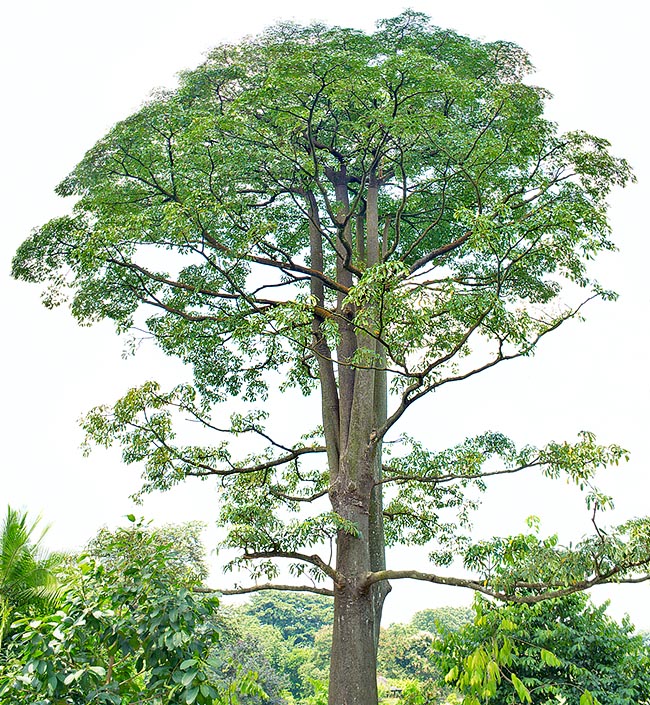Family : Apocynaceae

Text © Pietro Puccio

English translation by Mario Beltramini

Alstonia angustiloba is a 40 and more metres tree with 1 m trunk, often dominant in the mixed forests of dipterocarps and swampy forests of south-eastern Asia up to about 400 m of altitude © Giuseppe Mazza
The genus is honoured to the Scottish physician and botanist Charles Alston (1685-1760); the specific name is the combination of the Latin adjective “angustus, a, um” = thin and “lobus, a, um” = lobe, with reference to the lobes of the flower.
Common names: pulai tree (English); pantung, pelai, pulai, pulai bukit, pulai lilin (Bornean); pulai hitam (Indonesian); pulai, pulai bukit (Malaysian); mergalang (Sarawakian); gabus, goti, pelaik, pelawai, pulai, pule, tuturan (Sumatran); tin pet lek (Thai).
The Alstonia angustiloba Miq. (1857) is an up to more than 40 m tall semideciduous tree with erect trunk up to more than 1 m of diameter, provided at the base of tabular roots (flat roots similar to buttresses that help to supporting the great trees), up to 6 m tall, and greyish white to brown bark, smooth in the young specimens, then rough and vertically fissured; all parts of the plant contain a white latex exuding abundantly from the wounds.
The leaves, on a 1-3 cm long petiole grooved on top, are simple, arranged in verticils of 4-7, obovate to elliptic-oblong with attenuated base and slightly obtuse or pointed apex, curved entire margins and prominent central nervation, 4-15 cm long and 2-6 cm broad, coriaceous, of glossy green colour above, greenish grey below.

Species of high ornamental and landscape value, easy to cultivate and fast growing in tropical gardens. Is used in reforestation and the wood, light and tender, is used for common objects and by paper industry © G. Mazza
The inflorescences are compound umbel terminal carrying numerous imbutiform hermaphroditic flowers, with cylindrical tube slightly elated above, 0,6 cm long and 5 oblong-linear lobes, about 0,4 cm long, of cream white colour; the flowers emit an intense scent.
The fruits are dehiscent cylindrical follicles, curved, thin, brown and tomentose, up to 25 cm long and 0,3 cm of diametre, containing numerous seeds, almost rectangular, flat, about 0,5 cm long, provided of a tuft of silky hairs, 1 cm long, on the two extremities for favouring the dispersion through the wind. It reproduces by seed, in draining loam rich of humus maintained humid at the temperature of 24-26 °C, that germinates with a high percentage in 2-8 weeks, and by cutting.
Species of great ornamental and landscape value, of easy cultivation and fast growth, amply utilized, due to its luxuriant foliage and the intense scent of its flowers, in parks and gardens, as isolated specimen or in group, and as road tree in the tropical and subtropical climate countries, with high annual rainfall well distributed, in particular in south-eastern Asia; is also employed in the reforestation. Requires high constant temperatures, an exposition in full sun and grows in a vast variety of soils, average acidic to average alkaline, provided maintained almost constantly humid.
It is cultivated also for the wood, light and tender, easy to work, with which are produced tools and several common use objects (boxes, matches, pencils, sandals, etc.) and artistic, and for the fabrication of the paper.

Various parts of the plant are used since remote times in the popular medicine. Promising medicinal properties for treating cancers and malaria © Giuseppe Mazza
Synonyms: Alstonia calophylla Miq. (1857); Alstonia angustiloba var. glabra Koord. & Valeton (1894); Paladelpha angustiloba (Miq.) Pichon (1947).
→ To appreciate the biodiversity within the APOCYNACEAE family please click here.
